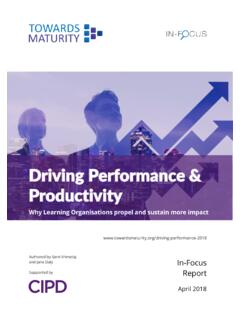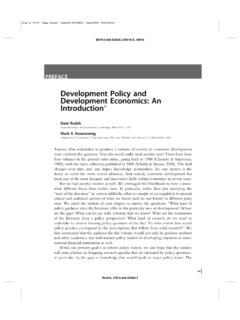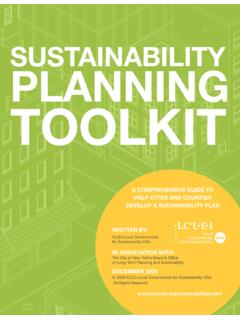Transcription of Official Development Assistance (ODA) - OECD
1 Official Development Assistance (ODA) | Development CO-OPERATION DIRECTORATEWHAT IS ODA? Official Development Assistance (ODA) is defined by the OECD Development Assistance Committee (DAC) as government aid that promotes and specifically targets the economic Development and welfare of developing countries. The DAC adopted ODA as the gold standard of foreign aid in 1969 and it remains the main source of financing for Development aid. ODA flows to countries and territories on the DAC List of ODA Recipients and to multilateral Development institutions are: i. Provided by Official agencies, including state and local governments, or by their executive agencies; and ii.
2 Concessional ( grants and soft loans) and administered with the promotion of the economic Development and welfare of developing countries as the main objective. The DAC list of countries eligible to receive ODA is updated every three years and is based on per capita income: ODA data is collected, verified and made publicly available by the OECD at statistics are the only source of Official , verified and comparable data on aid reported by 30 members of the OECD Development Assistance Committee (DAC) and about 80 other providers of Development co-operation, including other countries, multilateral organisations and private IS NOT ODA?
3 Military aid and promotion of donors security interests Transactions that have a primarily commercial objectives export credits Check the on-line database on ODA-eligibility: 2020 PRELIMINARY FIGURESA pril 2021 Official Development Assistance (ODA)OECD (2021), DAC 1 - Total Official and private flows | grant equivalent as percent of GNI (2020)ODA grant equivalent - USD billion (2020)ODA grant equivalent as percent of GNI (2020)ODA grant equivalent - USD billion (2020)SwedenNorwayLuxembourgDenmarkGerma nyUnited KingdomNetherlandsFranceSwitzerlandBelgi umFinlandTotal DAC CountriesJapanCanadaIrelandAustriaIcelan dNew ZealandHungarySpainItalyAustraliaSloveni aPortugalUnited StatesPolandSlovak RepublicKoreaCzech RepublicGreeceUnited StatesGermanyEU InstitutionsUnited KingdomJapanFranceSwedenNetherlandsCanad aNorwayItalySwitzerlandSpainDenmarkAustr aliaBelgiumKoreaFinlandAustriaIrelandPol andNew ZealandLuxembourgHungaryPortugalCzech RepublicGreeceSlovak target - 1520253035 ODA grant equivalent as percent of GNI (2020)ODA grant equivalent - USD billion (2020)
4 SwedenNorwayLuxembourgDenmarkGermanyUnit ed KingdomNetherlandsFranceSwitzerlandBelgi umFinlandTotal DAC CountriesJapanCanadaIrelandAustriaIcelan dNew ZealandHungarySpainItalyAustraliaSloveni aPortugalUnited StatesPolandSlovak RepublicKoreaCzech RepublicGreeceUnited StatesGermanyEU InstitutionsUnited KingdomJapanFranceSwedenNetherlandsCanad aNorwayItalySwitzerlandSpainDenmarkAustr aliaBelgiumKoreaFinlandAustriaIrelandPol andNew ZealandLuxembourgHungaryPortugalCzech RepublicGreeceSlovak target - 1520253035 Official Development Assistance (ODA) | Development CO-OPERATION DIRECTORATETHE MODERNISATION OF Official Development ASSISTANCEIn 2012, the DAC launched the modernisation of its statistical system in order to improve its accuracy while reflecting the changes in the Development co-operation sector, such as the growing importance of other providers non-DAC providers or philanthropic foundations, the diversification of financial instruments for Development , or the increasing overlap of Development co-operation policy objectives with those of other sectors such as migration and security.
5 In the process, the DAC took a series of decisions at its High Level Meetings in 2014, 2016 and 2017 with regard to the measurement of concessional loans to the public sector, private sector instruments, peace and security expenditures, and in-donor refugee costs. Over 2016-2018, a number of clarifications of eligibility rules for peace and security as well as in-donor refugee costs became effective. In 2019, the grant equivalent system became the standard for measuring ODA. Although data on the grant equivalent measure were collected and published during a transition period from 2016 to 2018, in 2019 it became the standard and ODA headline figures for 2018 applying this new standard were published for the first time.
6 Data on actual flows ( disbursements and loan repayments) continue to be collected and published to ensure transparency. Beyond 2020, the DAC will continue to adjust its statistical systems to new realities and needs. Work will continue to make the reporting of private sector instruments consistent with the new grant equivalent method. Work is also ongoing in relation to the methods for measuring the SDG focus of Development co-operation (purpose codes, policy markers) in view of keeping the statistical classifications relevant and fit-for-purpose with the 2030 new statistical framework: measures ODA loans more accurately and credibly, ensuring comparability of data across providers, encourages more and better allocation of concessional resources to implement the SDGs, promotes greater transparency and heightened accountability, helping to ensure that ODA goes where it is most needed and has the greatest Development next sections explain the changes in more to ODA grant equivalent (reporting on 2018 data)
7 , including for debt OF ELIGIBILITY RULES Ambiguities in reporting rules led to inconsistent interpretation and reporting by DAC members on both peace and security-related expenditures, and on in-donor refugee and security effortsIn 2016, the DAC agreed on updated rules for the eligibility of peace and security expenditures. This was to better recognise the marginal, but actual developmental role that military actors sometimes play, notably in conflict situations, while clearly delineating it from their main peace and security function. The changes clarify ambiguities to ensure uniform, consistent statistical reporting, but also to approve the ODA-eligibility of Development -related training for partner country military staff in limited topics.
8 Since then, the DAC has: implemented the updated ODA rules on peace and security in the reporting, issued a revised ODA Casebook on Conflict, Peace and Security Activities, and complemented the technical review of the ODA coefficient applied to UN peacekeeping MORE: (2017)22/FINAL/en/ refugee costs In 2017, the DAC agreed to clarify the reporting directives for assessing what may be included or not in ODA and provide its members with a blue print to use when accounting for the costs of assisting refugees in donor countries. There are five clarifications, with supporting explanatory notes: i) Rationale for counting in-donor costs as ODAU nderlines that refugee protection is a legal obligation and that the provision of Assistance to refugees may be considered a form of humanitarian ) Eligible categories of refugeesStates that categories must be based on international legal definitions.
9 Asylum seekers and recognised refugees are ) The 12-month rule Reaffirms that beyond 12 months, expenditures are outside the scope of statistics on international ) Eligibility of specific cost itemsExplains what cost items may or not be included in reporting, temporary sustenance (food, shelter, training) is eligible but not costs for integrating refugees into the economy of the donor ) Methodology for assessing costs Emphasises the need for a conservative approach that is accurate and transparent. The changes aim to improve the consistency, comparability, and transparency of DAC members reporting of ODA-eligible in-donor refugee costs. READ MORE: Development Assistance (ODA) | Development CO-OPERATION DIRECTORATE4 INTRODUCING THE GRANT EQUIVALENT A fairer method to record ODAODA can take the form of (i) grants, where financial resources are provided to developing countries free of interest and with no provision for repayment, or (ii) soft loans, which have to be repaid with interest, albeit at a significantly lower rate than if developing countries borrowed from commercial recently, grants and loans were valued in the same way.
10 By recording the flows of cash that were granted, or the face value of loans that were lent to developing countries, deducting any repayments on the loans. This cash basis or flow basis method, has been used to produce ODA headline figures until 2018 (reporting on 2017 ODA spending).The method was simple, but it did not reflect actual efforts by donor countries: a grant represents a bigger effort than a loan; and a loan with a very low interest rate and a long repayment period represents a bigger effort than a loan with a higher interest rate and a short repayment period. That is why DAC members decided, at their 2014 High-Level Meeting, to introduce a new way of measuring aid loans, so as to better reflect the actual effort by donor countries and their taxpayers: only the grant equivalent of loans would now be recorded as ODA.


















